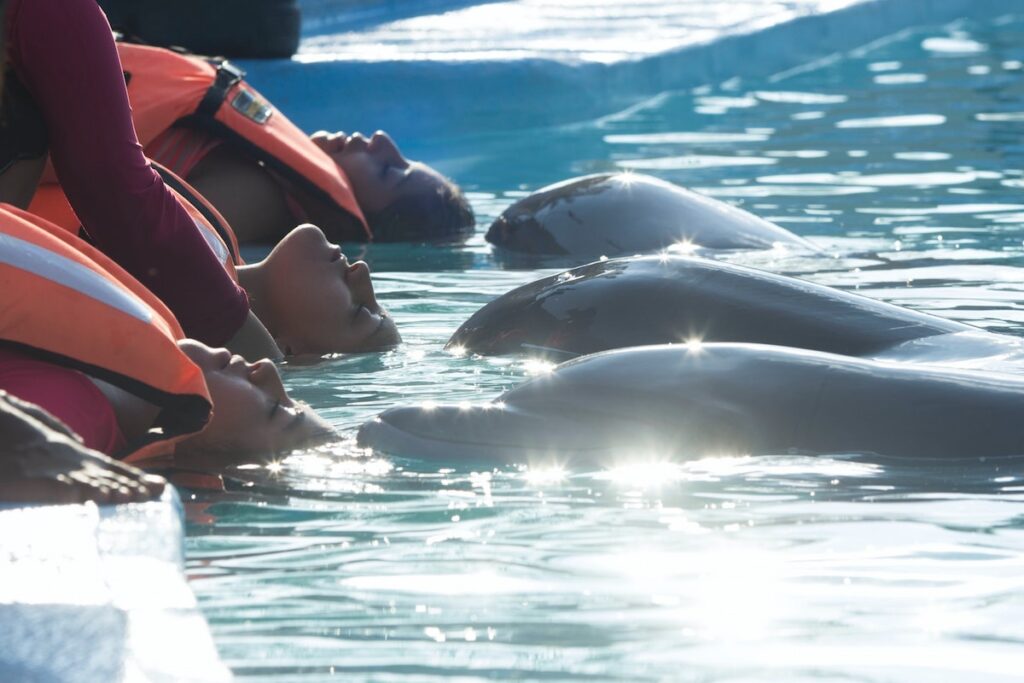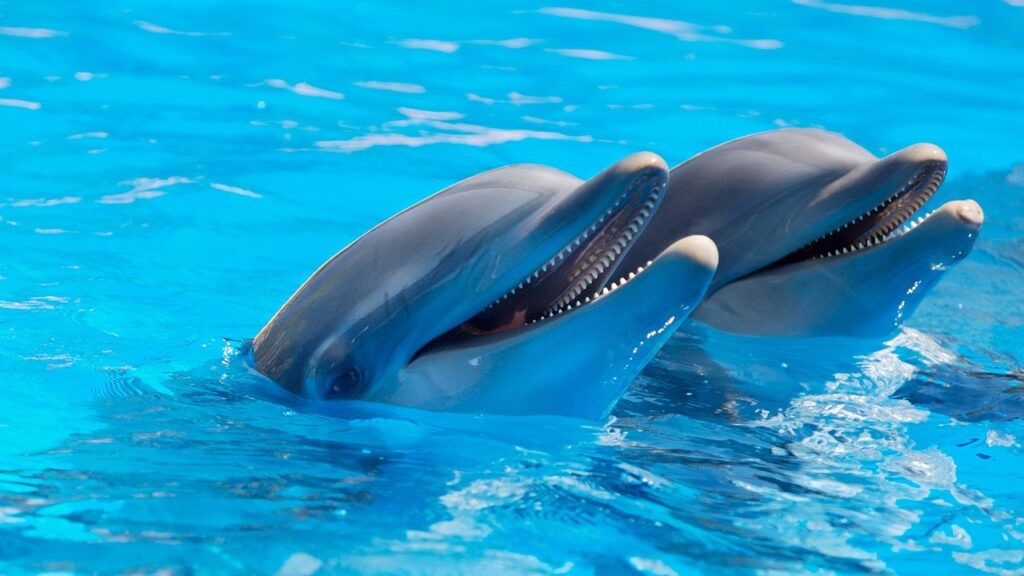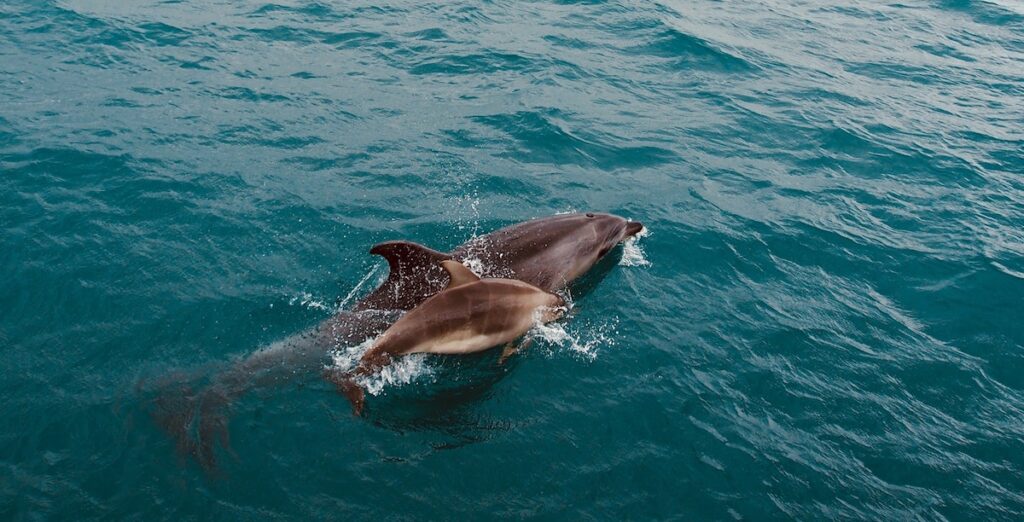Swimming with dolphins is on almost every person’s bucket list and research has shown that when humans interact with dolphins brain waves show a more relaxed and dream-like state than they did prior to the interaction. Dolphins are friendly creatures, and the interaction can stimulate the release of endorphins in humans, often referred to as our happy hormone.
This post may contain affiliate links. Please see our disclosure.

But, the feeling isn’t mutual for dolphins. Swimming with dolphins can be extremely detrimental, but human fascination has turned swimming with dolphins into a giant commercial industry for tourists and locals alike.
Where are swimming with dolphins activities popular?
You’ll find plenty of Swim with the Dolphins (SWTD) attractions in the coastal areas of the Southeastern United States, and quite a few of those are in the state of Florida. You’ll find plenty of dolphin tours in Panama City Beach and other surrounding beaches.
In recent years, between 14 and 18 SWTD attractions have been identified in the U.S., and many are a part of a larger marine life organization like an aquarium or zoo.
In 1990, the National Marine Fisheries Service estimated that over 40,000 people swam with captive dolphins in the U.S., and that number has drastically increased in the last couple of decades.
The typical cost to swim with a dolphin is $100 and $125 for an interactive session.
Swimming with dolphins — should you do it?
Reasons you should not swim with dolphins
They are wild animals, and can be dangerous.
Dolphins have a friendly reputation, but they are wild animals and human interaction can be detrimental.
Getting into a tank with a dolphin is theoretically no different than getting into a cage with a lion. Dolphins are apex predators and have the capability of killing a shark. There are accounts of dolphin attacks, most famously those by bottlenose dolphin Tiao and, while not a dolphin, Tilikum, the orca and subject of Blackfish.
A sample disclaimer from SeaWorld’s Discovery Cove states in part: “You are agreeing to let your minor child engage in a potentially dangerous activity. You are agreeing that, even if the released parties use reasonable care in providing this activity, there is a chance your child may be seriously injured or killed by participating in this activity because there are certain dangers inherent in the activity which cannot be avoided or eliminated.”
The USDA took over the responsibility of overseeing SWTD programs in 1994, but operators aren’t required to report injuries to staff or visitors.
They are wild animals that are captured.
SWTD attractions also break up families. When dolphins are captured, it’s not guaranteed that each dolphin in the family pod is captured nor that they end up in the same place. Dolphins form strong bonds with their family pod, and forcing dolphins to bond in artificial pods often leads to severe tank aggression.
In 1972, the Marine Mammal Protection Act was passed, but it didn’t protect dolphins from being captured, just required a permit to do so and proof of one of the following reasons: scientific research, public display, accidental capture, or conservation.
Attractions and programs will often trade dolphins from place to place to breed animals and prevent inbreeding. Trading also makes sure young calves do not disrupt the entertainment of shows.
According to World Animal Protection, bottlenose dolphins are six times more likely to die immediately after capture from the wild and in between facilities. Dolphins aren’t smiling. It’s just the shape of their face.
Dolphins will look like they’re smiling, even when they’re dead.
That’s right. What looks like happiness to humans is just the anatomy of dolphins. The dolphin industry takes advantage of this misinterpretation to cover cruelty.
“A dolphin’s smile is the greatest deception. It creates the illusion that they’re always happy.”
― Richard O’Barry

Captivity and entertainment lead to extreme stress.
A myriad of problems come from holding dolphins captive, and in turn, training them to interact with humans and put on shows. Life in captivity can never compare to life in the wild.
Each dolphin in an SWTD attraction must become accustomed to interacting with humans regularly, which requires extensive training. None of the behaviors you often see in interactions and shows are natural dolphin behaviors.
A pod of wild dolphins can travel up to 100 kilometers a day in the open ocean, and being in a limited space can lead to self-destructive behavior, especially when grouped with other dolphins not from their family pod.
Stress in dolphins can be seen in symptoms such as weight loss, lack of appetite, anti-social behavior, swimming in circles, gnawing on the walls or gates of their tanks, and floating lifelessly.
In 2010, British researchers found that swimming close to bottlenose dolphins and touching them created stressful environments that prevented them from resting, feeding, and nurturing their young.
Most SWTD programs take place in heavily chlorinated tanks or ocean pens, and both environments leave dolphins exposed to harmful conditions. The chlorine and other chemicals are damaging to the eyes and skin of the dolphins, and can even blind them.
Captive breeding program problems
When you purchase a ticket to a SWTD attraction or program, you are directly supporting and encouraging breeding in captivity.
When dolphins are bred in captivity, calves are often taken from mothers too early to start their training. In the wild, dolphins will stay with their mother anywhere from three to six years.
Conservation is disturbingly minimal
Most SWTD attractions claim to be conservation programs but they really aren’t. Venues that promote breeding as conservation such as zoos, aquariums, and special attractions like SeaWorld, often put less than 1% of their revenue into protecting wild animals.
Bottlenose dolphins, which are the most used species of dolphins for swimming attractions, are not even currently on the endangered species list, meaning that the conservation argument for SWTD attractions is not an issue in most cases.
What about swimming with wild dolphins?
There are a few ways you can swim ethically with wild dolphins, but it’s advised that you observe them from a distance of at least 50 feet.
New Zealand banned swimming with dolphins in late 2019 because visitors were “loving the dolphins too much” and leaving a lasting impact on the population. The number of dolphins frequenting The Bay of Islands has dropped by 66% since 1999.
Hawaii has also limited the area that wild dolphins can be interacted with to a 50-yard barrier around the mammals frequent area, meaning that people and boats are not allowed in the area no matter the time of day or year.
With that being said, divers who have witnessed wild dolphins know that there is no comparison to other ocean experiences. Dolphins are at ease in the ocean, but divers are visitors. Before you go for a dive where you could potentially see dolphins, be sure you know about the rules and regulations in your area.
- Many countries, including the U.S., have strict restrictions about approach distances and being around dolphins in the wild. If you are going scuba diving, make sure to research dive companies and tour operators that are reputable, responsible, and knowledgeable about sustainable practices before choosing one.
- Make sure to wear the appropriate equipment for interacting with animals. For example, some animals behave and interact more naturally with snorkelers than divers.
- Make sure that you maintain a distance that keeps the animals comfortable. Learn their behaviors to make sure you know the difference between good and bad behaviors.
Be wary of any opportunity advertised as swimming with wild dolphins, because interaction with wild dolphins can result in disease transfer even with the seawater acting as an effective disinfectant.
Always do your research, though, since many tours that bill themselves as “swim with wild dolphins” encounters try to trap or corral the animals or target them when they move into shallow areas to rest and bombard them with tourists day after day.
Feeding dolphins — should you do it?
To make a long answer short: no. Really. It’s illegal so feeding and harassing wild dolphins and not observing them from at least 50 feet could land you a fine of up to $100,000 and/or up to one year in jail. And while avoiding fines and jail time is certainly a motivation, there are dangers to dolphins by feeding them.
Dolphins are hunters, not beggars.
Just like you wouldn’t feed a bear in a national park, don’t feed a wild dolphin. By doing so, you’re creating a bad behavior that makes it seem like begging will always get them food.
They’ll lose their fear of humans.
Feeding a dolphin makes them even more friendly than they already are to humans. Dolphins who are more comfortable with humans have been known to bite.
They’ll also lose their fear of boats.
Encouraging dolphins to come close to your boat to get a bite to eat encourages a dolphin to continue that behavior with every boat it sees. Coming too close to boat propellers has and can result in severe or even fatal injuries.
How to see dolphins ethically
There are plenty of ways to observe dolphins without endangering them or yourself.
Take a dolphin watching tour
- It’s perfectly okay to see dolphins on a watch tour, but make sure to find a certified tour operator. A certified operator will usually have a symbol on their boat or credentials on their website.
- Make sure if you’re watching that boat engines are turned off or lowered when near. Dolphins have sensitive hearing and echolocation skills and loud sounds and boat engines can disturb their environment.
- Be sure you’re on a tour that doesn’t encourage feeding animals or that forces interaction with the dolphins you do come across. A responsible tour guide also ensures that any items like bottled drinks brought on the boat leave the boat and are not thrown in the ocean.
- Choose a company with a SMART certification, which is a program promoting responsible stewardship of wild dolphins in coastal waterways.
Know how to be Dolphin S.M.A.R.T
- Stay back 50 yards from dolphins.
- Move away cautiously if dolphins show signs of disturbance.
- Always put your engine in neutral when dolphins are near.
- Refrain from feeding, touching, or swimming with wild dolphins.
- Teach others to be dolphin smart.
Swim with robotic dolphins
We may not all have the breathtaking opportunity to swim with dolphins as they curiously approach us on a dive, but there is new technology to provide an animatronic substitute.
Edge Innovations has a great example of a life-sized realistic robotic dolphin, designed by Holzberg and Conti. The “robodolphin” looks and swims like a real bottlenose dolphin and even reacts to human gestures. It has been engineered to simulate everything, and there are plans to add a functioning blowhole before mass production.
Holzberg and Conti have even been awarded PETA’s Innovator for Animals Award.
Kayak or stand-up paddleboard
Once you’ve rented a kayak or paddleboard, ask your rental company or a local tour guide where to find dolphin pods, along with sea turtles, manatees, and other wildlife that are possibly hanging around.
You’ll be practically under the radar of the dolphins since both kayaks and paddleboards are non-motorized. You may just get super lucky!
Take a dolphin volunteer trip
If you’re wanting to watch dolphins in a more rewarding way, consider joining a dolphin volunteer trip like the Ionian Dolphin Project in Greece. For over 25 years, over 1,500 nonspecialist enthusiasts of marine conservation from across the world have joined the project. If you join the program, you’d help fuel research and conservation initiatives.
Best places to see dolphins in the wild
There are so many places around the world to see dolphins in the wild. With almost 50 different species of dolphins, there’s a place to see dolphins in almost every corner of the world. But, there is definitely a list of best destinations to see wild dolphins!
- The Azores, which is a Portugal archipelago in the middle of the Atlantic, is home to 11 species of dolphin. Pods can reach up to 1,000 individuals in these warm waters, and dolphins often come close to shore to feed.
- Hawaii is a dreamy place to go to dolphin watching because of its warm and clear waters. The spinner dolphin is a popular species to see in the state outside of its protected area. Hawaiian dolphins tend to live in large pods, and you often see them leaping in and out of the waves.
- New Zealand is one of the best places to see wild dolphins. Kaikoura, New Zealand’s South Island, is home to four different dolphin species, one of which is the dusky dolphin with shades of black, grey, and white.
- Florida beaches such as The Keys, Panama City Beach, and Madeira Beach are some of the best places to see dolphins in the states. If you’re lucky, you’ll end up on a boat off any of these coasts with dolphins chasing you as they leap in and out of the water.

Companies that have banned swimming with dolphins and similar activities
It is worth mentioning a few large tourism companies that have banned this activity from being listed on their platform:
- Virgin Holidays
- TripAdvisor
- Airbnb
- Thomas Cook
Meanwhile, other tourism giants such as Expedia are still insistently selling swim with dolphins activities.
Dolphin fun facts
Are dolphins endangered?
Dolphins as a species are not endangered, but there are some subspecies such as Ganges River Dolphin, Hector’s Dolphin and Irrawaddy Dolphin that face endangerment.
Are dolphins intelligent?
Dolphins are some of the smartest marine animals and are often referred to as the brainiacs of the sea. Their bodies, brains, sensory systems and intelligence have all evolved and adapted for living their best lives.
What is a group of dolphins called?
A group of dolphins makes up a pod. Dolphins are extremely social and interact with one another while swimming and hunting, and often protect each other. Living in pods helps protect dolphins from predators like sharks.
Are sharks afraid of dolphins?
While it’s unclear if sharks are scared of dolphins, a dolphin can seriously injure or kill a shark while hunting for food.
Where do captive dolphins come from?
Unethical capture
- Dolphins are chased to exhaustion by speedboats, which separate a few dolphins from the rest of the group and corral them with a net.
- Panicked dolphins often injure themselves trying to escape the net, and death (usually by drowning) is common. Studies suggest that mortality rates increase six-fold after capture.
- The dolphins may then be subjected to further trauma during travel in boats, shallow pens on trucks, or between countries on long-haul flights.
Captive breeding
- When dolphins are bred in captivity, calves are often taken from mothers too early to start their training. In the wild, dolphins will stay with their mother anywhere between three and six years.
- In June 2019, Canada’s Parliament passed legislation that banned whales, dolphins, and porpoises from being bred or held in captivity. Any animal already in captivity was not released.
Are there tanks that give dolphins in captivity enough space?
- The Animal Welfare Act enacted in 1979 sets the standards for the care of captive marine mammals. The USDA has the authority to enforce the AWA, which establishes guidelines for space requirements, quality of water and sanitation, transportation and handling, food quality and diet, and veterinary care.
- According to the space requirements under the AWA, a bottlenose dolphin can be confined in a space that measures no more than 24 ft by 23 ft and just 6 feet deep.
- Dolphins are used to swimming up to 40 miles a day in the wild.
How are dolphins trained?
Dolphins are trained to perform through ‘operant conditioning.’ This means that satisfaction of hunger is dependent on performing tricks; for others, hunger is deliberately induced so the training will be effective. Though a complete food portion is ultimately provided each day, the use of food as a training tool reduces some animals to little more than beggars.
They often work 12-hour days without a break. During performances or petting sessions, their ears are assaulted by blaring music and the noise of people splashing water or slapping the sides of the tank to get their attention. In petting pools and feeding programs, the dolphins’ health may be further compromised by people placing foreign items into their mouths. All of this takes a heavy toll on dolphins, often resulting in stress-related illnesses and even death.
How to help dolphins
Educate yourself and others.
Read books about dolphins.
- Death at SeaWorld by David Kirby
- Future Sea: How to Rescue and Protect the World’s Oceans
- Ocean Conservation’s Reading List
Watch documentaries and films.
- Blackfish (Netflix or Amazon)
- Seaspiracy (Netflix)
- The Cove (Amazon)
Sign the “Wildlife not Entertainment” pledge
Support companies that support dolphins
- 8 of the Best Hikes near Gatlinburg for All Skill Levels and Seasons - November 5, 2023
- 16 Sustainable Swimwear Brands to Check Out This Summer - June 14, 2023
- The Best Shark Gifts for the Shark Enthusiasts - September 7, 2022




